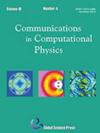A Comparative Study of Hydrodynamic Lattice Boltzmann Equation in Phase-Field-Based Multiphase Flow Models
IF 3.1
3区 物理与天体物理
Q1 PHYSICS, MATHEMATICAL
引用次数: 0
Abstract
In recent years, phase-field-based models for multiphase flows have gained significant popularity, particularly within the lattice Boltzmann (LB) community. These models typically use two lattice Boltzmann equations (LBEs), one for interface tracking and the other for solving hydrodynamic properties. However, for the purposes of this paper, we focus only on the LB model for hydrodynamics. Our goal is to undertake a comparative investigation into the differences between three classical hydrodynamic LB models proposed by Lee et al. [1], Liang et al. [2] and Fakhari et al. [3]. The interface-tracking equation used in this study is based on the conservative phase-field model. We provide a detailed derivation of the governing equations in each model using the Chapman-Enskog analysis. Additionally, three discretization methods for the interaction forces are introduced, and a modified method for the gradient term is proposed based on the nonequilibrium distribution method. The accuracy of three LB models in combination with four discretization methods is examined in this study. Based on the results, it appears that different combinations of models and methods are appropriate for different types of problems. However, some suggestions for the selection of hydrodynamic models and discrete methods for the gradient term are provided in this paper.基于相场的多相流模型中的流体力学晶格玻尔兹曼方程比较研究
近年来,基于相场的多相流模型大受欢迎,尤其是在晶格玻尔兹曼(LB)领域。这些模型通常使用两个晶格玻尔兹曼方程(LBE),一个用于界面跟踪,另一个用于求解流体动力学特性。不过,在本文中,我们只关注流体力学的 LB 模型。我们的目标是比较研究 Lee 等人[1]、Liang 等人[2]和 Fakhari 等人[3]提出的三种经典流体力学 LB 模型之间的差异。本研究中使用的界面跟踪方程是基于保守相场模型的。我们利用查普曼-恩斯科格分析法详细推导了每个模型的控制方程。此外,我们还介绍了三种相互作用力离散化方法,并在非平衡分布法的基础上提出了梯度项的修正方法。本研究考察了三种 LB 模型与四种离散化方法相结合的精度。从结果来看,不同的模型和方法组合适用于不同类型的问题。不过,本文对梯度项流体力学模型和离散方法的选择提出了一些建议。
本文章由计算机程序翻译,如有差异,请以英文原文为准。
求助全文
约1分钟内获得全文
求助全文
来源期刊

Communications in Computational Physics
物理-物理:数学物理
CiteScore
4.70
自引率
5.40%
发文量
84
审稿时长
9 months
期刊介绍:
Communications in Computational Physics (CiCP) publishes original research and survey papers of high scientific value in computational modeling of physical problems. Results in multi-physics and multi-scale innovative computational methods and modeling in all physical sciences will be featured.
 求助内容:
求助内容: 应助结果提醒方式:
应助结果提醒方式:


